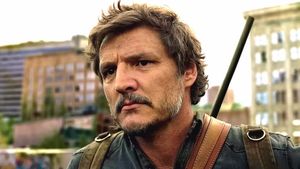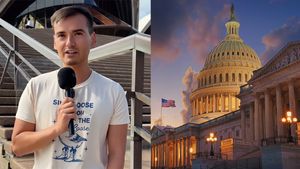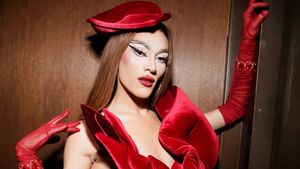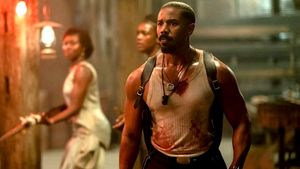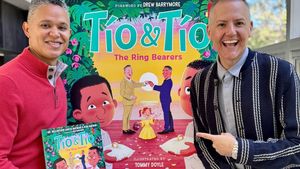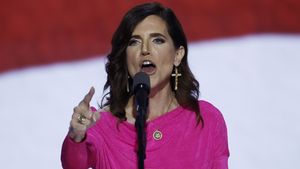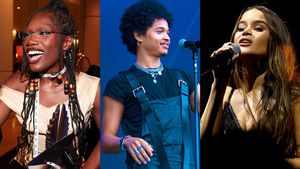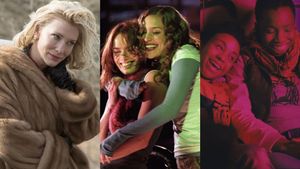
CONTACTAbout UsCAREER OPPORTUNITIESADVERTISE WITH USPRIVACY POLICYPRIVACY PREFERENCESTERMS OF USELEGAL NOTICE
© 2025 Equal Entertainment LLC.
All Rights reserved
All Rights reserved
By continuing to use our site, you agree to our Private Policy and Terms of Use.
Harvey Milk on Election Night
Dan Nicoletta began his career as a freelance photographer in 1975 as an intern to Crawford Barton, who was then the staff photographer for The Advocate. Dan also worked in Harvey Milk's camera store in the heart of the burgeoning LGBT mecca in the Castro district and was also involved in Milk's election to the city's board of supervisors, which made him one of the first openly gay elected officials in the world. Nicoletta's photographic work maps his enduring romance with San Francisco and its people, especially the lesbian, gay, bisexual, and transgender populations, and he remains a key point person for LGBT-related research.
Nicoletta's work has been featured in numerous settings, including the Academy Award-winning film Milk by Gus Van Sant, the Academy Award-winning documentary The Times of Harvey Milk by Rob Epstein and Richard Schmiechen, and the award-winning documentary Sex Is by Marc Huestis and Lawrence Helman.
Dan's work has also appeared in numerous periodicals and books, including Randy Shilts's The Mayor of Castro Street, Susan Stryker and Jim Van Buskirk's Gay by the Bay, and Harold Evans's The American Century and also the 10-year anniversary catalog Out at the Library: Celebrating the James C. Hormel Gay and Lesbian Center.
Harvey Milk and Denton Smith
The Advocate: Why are you a photographer?
Dan Nicoletta: I started as a film student and found filmmaking to be too clunky then and with less promise of fiscal prosperity than still photography, so I segued to stills. Its hugely ironic to me that the language of still photography now includes motion capability, which is great, but I also love what can be conveyed in a single image.
What catches your eye?
I am deeply in love with my fellow human beings. I started from the Arbus tradition of meditating on our foibles, but I have more recently morphed into the romantic tradition of someone like Brassai, who had the wisdom to document the queer life of Paris in the '30s before it vanished. Like Brassai's, I want my documentation to be poignant but also stunning and gorgeous to look at, not repellent, though I don't shy away from exploring most things. There is still a little of what I lovingly call the Arbutic in me.
How do you choose your subjects?
It's like peeling the onion -- I only need to go down one layer to find what is meant to be next. In recent years I have decided to only work within my immediate sphere, friends and soul mates or work colleagues. San Francisco never disappoints, so I am photographing strangers less and less. But occasionally I will also select a challenge and explore outside of my comfort zone, especially if it's an area of the LGBT community that is underrepresented in my work, which I hope will continue to serve to reflect back the times and inspire positive movement forward.
How do you describe your work?
I often describe myself as a chronicler of the gay, lesbian, bisexual, transgender journey. I have been lucky to call that civil rights movement my beat for the last 36 years since I arrived in S.F. at age 19 in 1974 and stumbled into Harvey Milk's camera store looking for a place to develop my Super 8 films. There is something wondrous about being an insider documenting any scene, I think that's an important facet of my work, that I am concentrating on creativity that pertains to my life.
What makes a good photograph to you?
In portraits, when the sitter's soul comes forward in the photo, and in verite work when the photo is poetic and brimming with poignant and inspiring symbolism.
Who are your favorite artists? And why?
Lately I have been crazy for Jean-Paul Goude and also Thomas Kelly's portraits of Indian sadhus. I have always loved Erwin Olaf ... I am constantly looking to see how others handle the challenges of visual colonization and still make good and balanced work. All of those artists have adept curiosity and integrity around those nuances and issues.
Willie and Sylvester
Matt Madrigal and Hubert Johnson
Chris Mende and Ruth Bernhard
New Year's Day on Castro Street
Kevin and Teabag at the Stud
The Sisters of Perpetual Indulgence in the Castro
Scorchy's holster
Self-portrait
Marcus Ewart (homage to Diane Arbus)
Danny Celeri
From our Sponsors
Most Popular
31 Period Films of Lesbians and Bi Women in Love That Will Take You Back
December 09 2024 1:00 PM
18 of the most batsh*t things N.C. Republican governor candidate Mark Robinson has said
October 30 2024 11:06 AM
True
These 15 major companies caved to the far right and stopped DEI programs
January 24 2025 1:11 PM
True
Latest Stories
'The Francis Effect': What Pope Francis did, and couldn’t do, for the LGBTQ+ community
April 21 2025 6:00 PM
LGBTQ+ and other leaders call Pope Francis progressive and transformative
April 21 2025 5:15 PM
Sasha Colby's 'Stripped II' tour spotlights the trans experience
April 21 2025 3:42 PM
Senate staffer accused of having sex in Capitol building recounts 'horrific' backlash
April 21 2025 12:03 PM
20 years of Sapphic cinema: the 20 best lesbian movies
April 21 2025 1:23 PM
Pope Francis changed the conversation on LGBTQ+ Catholics—will the next Pontiff hit mute?
April 21 2025 12:00 PM
Trump Administration to defund suicide hotline for LGBTQ+ youth starting in October
April 21 2025 3:54 PM


































